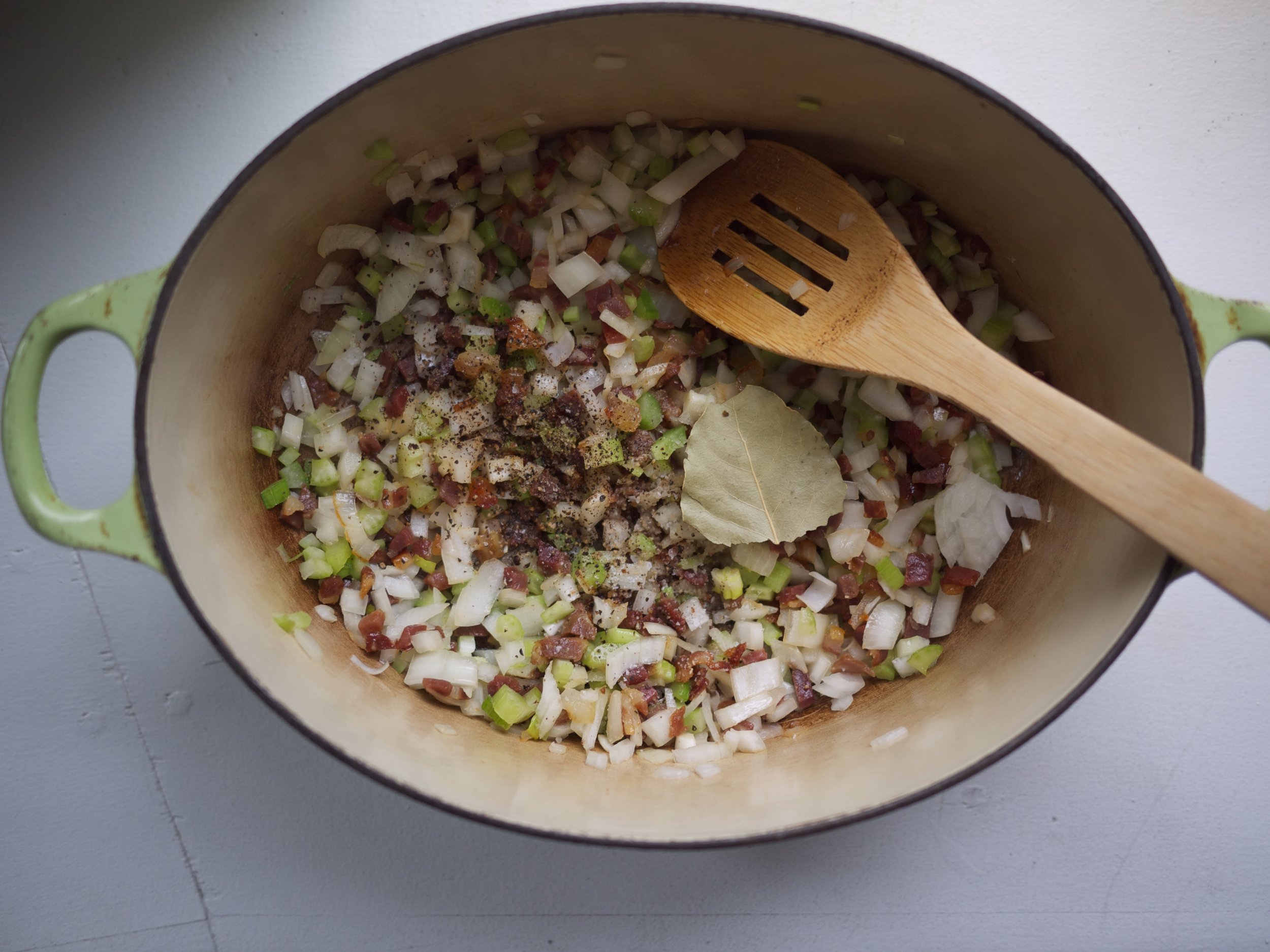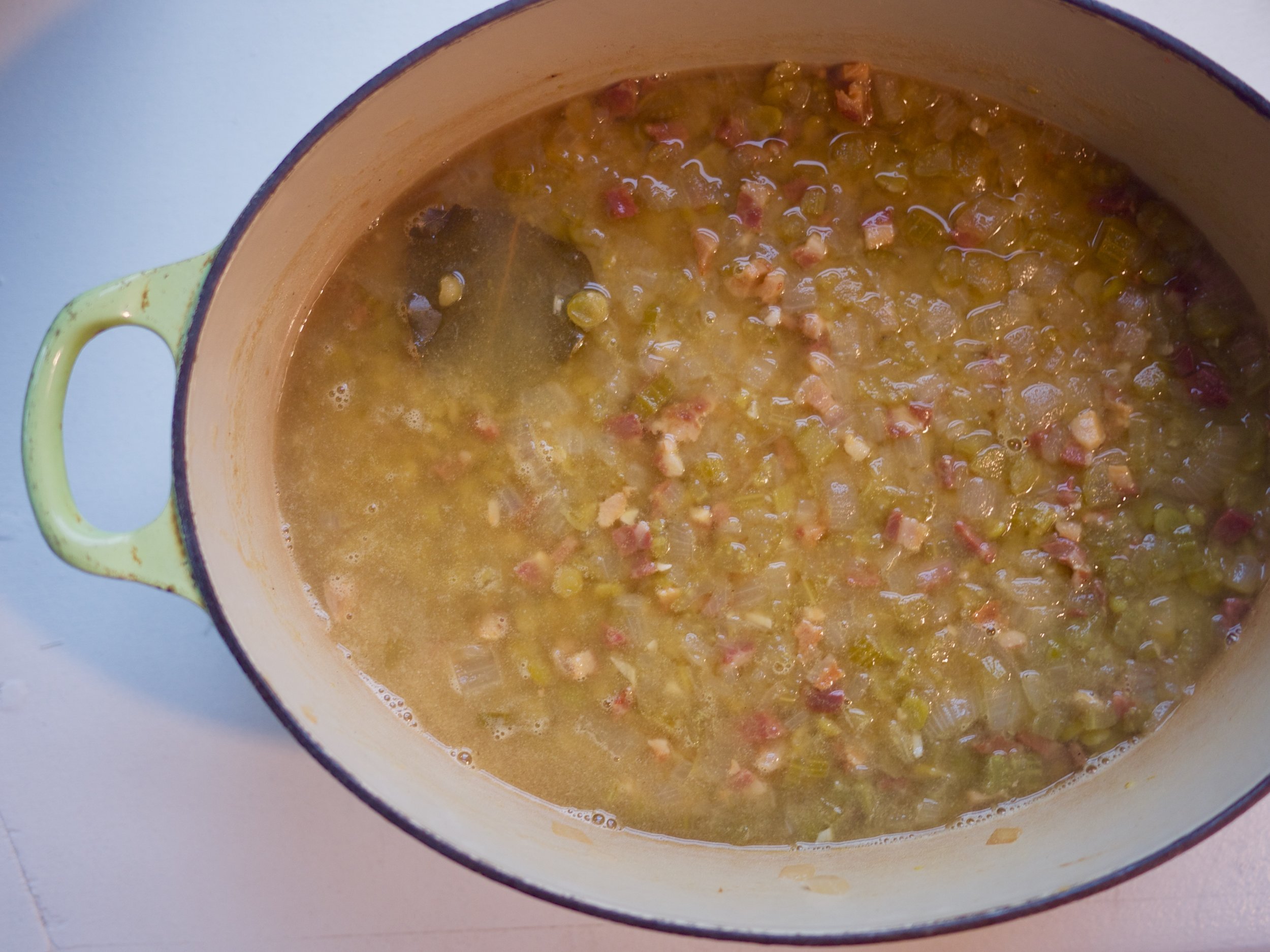The children’s book George and Martha—a collection of stories by James Marshall regarding two hippos in a vaguely defined relationship—was always a favorite of mine.* One story in particular, about Martha making split pea soup and George not wanting to eat it so intensely that he pours it into his loafers under the table, always stuck with me. The emotional complications of wanting to avoid conflict while being faced with the horror of eating something unpleasant resonated deeply. As a child and as an adult, I’ve always wanted to please, and my career centers around cooking, writing about, and eating food that I like. So the prospect of eating yucky soup or telling your loved one that you hate their soup would be a very fraught choice.
Marshall’s fabulous illustrations really illuminate the drama. I love that George’s loafers are a delightful melon-pink, the type of soft red that Italian men (and hippos, I guess) wear confidently, a lovely contrast with that tilting plane of olive-green soup. Culinarily, however, George’s solution did serious harm when it came to the stock value of split pea soup. As in Oppenheim’s fur teacup breakfast, a lunch being slipped into loafers equals a gross-out worthy of surrealists and children alike. It’s hard to overcome that image.
Luckily, in regard to this particular conflict, Martha spots George with the slippers and confronts him. It turns out that Martha likes making split pea soup, but neither George nor Martha actually likes eating it, so through what some might call "assertive but not aggressive" discussion, accord is restored to their mysterious union.
I too like to just make soup sometimes. It is like money in the bank: a healthy, wholesome thing that can bubble away on the stove quietly and pleasantly, to be packed up and eaten for lunch. So I recently made split pea soup, which isn’t my favorite but sounded kind of fun to make, and told my husband after, thinking he’d be psyched. But alas, he reminded me that he, too, doesn’t like split pea soup. Too late. Like Martha, sometimes I just like to cook a thing because I like the process, even if the end result isn’t that popular. Art imitating life? A stretch. Obliviousness to facts that I don’t care to accept? More likely.
But then we tried the soup, and, if I don't say so myself, it was pretty delicious. There was an obvious reason for its singular appeal. A secret weapon, deep from the depths of the freezer: a prosciutto end.
Of course, prosciutto is ham, and ham and split peas are nothing new. But prosciutto is a very special Italian, unsmoked, cured ham, and the end is one of those surprising ingredients that will make many dishes inherently better. The narrowest part of the pig’s leg, it is difficult to be safely cut into slices, which is why it’s sold as a piece. Because there’s only one end per leg of prosciutto, it can be hard to procure. Your best bet is to ask at the deli or butcher, or just keep your eyes peeled in forgotten refrigerated corners of specialty shops. I bought mine at an Italian foods store months ago, the type of place where you order everything at the counter; I sniffed it out in the somewhat dejected serve-yourself case of prepackaged cheeses. Opposed to the mortgage-threatening cost of sliced prosciutto, the end is always priced to sell: a remarkable ingredient, disguised as a castoff.
As intensely flavored as the rest of the ham, the end has a texture that’s less melting and more dry, often covered with a layer of fat. (Though honestly the dryness may be because I always freeze mine, not knowing when the inclination to use it will strike.) But its lackluster looks/store presentation is another way it deceives people. Those people might ask (in a potentially annoying tone): Why buy a dry hunk of prosciutto that you can’t even make a mozzarella sandwich with? Or drape artfully over cantaloupe? Or wrap around asparagus? (Or whatever other fancy things people do with prosciutto?) Because this humble hunk will make sauces, stews, beans, and risottos taste wonderful. Dice it up—just a quarter pound will flavor a whole pot of beans for example—and add it to any soup or pasta dish. Anywhere where you might flavor something with bacon or pancetta, replace with this, its unsmoked cousin. There are all sorts of delicious options once you get your hands on one. Try to find one! Your split pea soup haters, or at least their loafers, will thank you.
Prosciutto-End Split Pea Soup
Dice up the prosciutto end (both the meat and the fat—don't be crazy) and cook it slowly in a large pot or Dutch oven to render the fat and brown the meat; if needed add a tablespoon of olive oil to get it started. Add 2 or 3 chopped stalks of celery and a small chopped onion (and a peeled and chopped carrot if you have one); cook until softened. Add 2 chopped garlic cloves, a bay leaf, 1 pound of sorted split peas,** a spoon of chicken bouillon if you like, and water to cover. Simmer slowly until peas are soft; add more water as needed to keep them covered. Blitz with an immersion blender until as smooth as you like it; taste and reseason with salt and lots of pepper. A squeeze of lemon (and/or a sprinkle of ever-present pul bibir) over your bowl might lift the flavor in a pleasant way, but it’s up to you.
Alternate things to do with your prosciutto end:
- Risotto: Dice and brown the prosciutto end, then start a risotto in it. If you like, add fresh peas five minutes from the end of cooking.
- Greens: Dice and brown the prosciutto end, then add cleaned chopped greens (turnip, collard, beet, kale) and a splash of water and cook, covered, until greens are tender. Finish with a few drops of vinegar or lemon juice.
- Tomato sauce: Dice and brown the prosciutto end, sauté with a chopped onion and garlic, then simmer with canned tomatoes. Finish with lots of chopped parsley and toss with cooked pasta.
- Hammy mac and cheese: Dice and brown the prosciutto end, then add to your bechamel with the cheese. Proceed as you like.
- Minestrone: Dice and brown the prosciutto end, then proceed.
- White beans: Cook the beans* until just tender. Dice and brown the prosciutto end, then sauté an onion and garlic, then add the beans and some of the cooking liquid. You can add a parmesan rind here too. Cook on very low until the beans are very tender and tasty. Serve over polenta (also good with a parm rind) with garlicky sautéed escarole.
- Braised chicken: Brown some chicken thighs in a large pan, then remove from the pan. Brown the diced prosciutto end, then add an onion, mushrooms, and garlic and cook until softened. Add the chicken back in with some wine and/or broth, cover, and cook until the chicken is done. Chopped tarragon would be nice at the end of cooking.
* I’ve been scooped by the NYT. Great article about George and Martha here.
** Take it from a former nay-sayer: I HIGHLY recommend actually sorting through the peas (or any dried beans) before rinsing and pouring them directly into your soup pot. The bag will also instruct you to do this, but you might consider skipping for your own laziness. DON’T. This last time, I found two actual tiny pieces of gravel in my soup. It’s very disconcerting.







